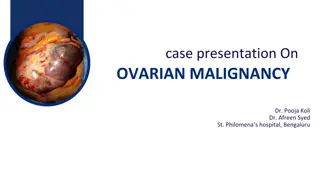Understanding Malignant Melanoma: Types, Signs, and Prognosis
Malignant melanoma is a serious skin cancer with various types, including superficial spreading, nodular, acral lentiginous, lentigo maligna, and amelanotic. Recognizing early signs such as ABCDEF (Asymmetry, Borders, Colour, Diameter, Evolving, Funny-looking) is crucial for prompt diagnosis. Macros
2 views • 25 slides
Understanding Grading and Staging of Malignant Tumors in Cancer Patients
Grading and staging are crucial in determining the aggressiveness and extent of malignant tumors. Grading involves assessing the level of malignancy based on cell differentiation and mitotic activity, while staging considers the size of the tumor, lymph node involvement, and presence of metastases.
7 views • 31 slides
Understanding Uterine Leiomyosarcoma: A Case Presentation
A 58-year-old female with a history of fibroids presented with post-menopausal bleeding and was diagnosed with uterine leiomyosarcoma, a rare and aggressive malignancy of uterine smooth muscle cells. The case details the clinical course, diagnosis, and prognosis of this condition, emphasizing the im
0 views • 17 slides
Understanding Intestinal Obstruction: Causes, Classification, and Pathophysiology
Intestinal obstruction can be classified into dynamic and adynamic types, with various causes such as intraluminal faecal impaction, malignancy, and hernia. The pathophysiology involves changes in bowel peristalsis and dilation, leading to potential strangulation and ischemia. Morbidity and mortalit
9 views • 40 slides
Radiology-Pathology Correlation Case Presentation: Ms. DR - Lung Mass Evaluation
Ms. DR, a 62-year-old female with a history of tobacco use, presents with a right lung mass and possible metastatic disease. Imaging reveals a FDG-avid lung mass suspicious for primary malignancy. After obtaining informed consent, a CT-guided core biopsy is performed, showing cohesive, medium-sized
1 views • 16 slides
Parathyroid Carcinoma Misdiagnosed as Thyroid Lesion: A Case Study
Parathyroid carcinoma (PC) is a rare malignancy often challenging to differentiate from benign thyroid nodules. This case study highlights a 50-year-old male patient whose nonfunctioning sporadic PC was initially misidentified as a follicular thyroid nodule. Despite preoperative evaluations, includi
4 views • 27 slides
Understanding Endometrial Cancer: Risk Factors, Diagnosis, and Management
Endometrial cancer, the most common gynecological malignancy in women, presents with abnormal uterine bleeding and affects women mainly during menopause. Risk factors include hormonal stimulation and estrogen levels. Differentiating between types of endometrial cancer can impact treatment decisions.
3 views • 31 slides
Understanding Scrotal Bumps and Lumps: Hydrocele and Spermatocele
Scrotal bumps and lumps such as hydrocele and spermatocele are common conditions among males, particularly adolescents. Hydrocele, a collection of fluid in the layers of the scrotum, usually presents as painless swelling and may be idiopathic or secondary to various causes. On the other hand, sperma
0 views • 33 slides
Approach to a Thyroid Nodule: Causes, Diagnosis, and Management
When encountering a thyroid nodule, it is essential to consider both benign and malignant causes. Clinical features may vary, and investigations such as ultrasonography, FNAC, and thyroid scanning play crucial roles in evaluation. Understanding the findings suggestive of malignancy is key for approp
0 views • 32 slides
Parenteral Nutrition in Intestinal Failure Related to Advanced Abdominal Cancer
Discussion on parenteral nutrition in patients with intestinal failure secondary to advanced abdominal cancer, including considerations for patient selection, Christie referral pathway, and practicalities of home parenteral nutrition. The background highlights the increasing commonality of home pare
0 views • 40 slides
Differential Diagnosis of Ascites in a 50-Year-Old Man with Liver Disease
Ascites, jaundice, and confusion in a 50-year-old man raise concerns about liver disease. Differential diagnosis includes cirrhosis, malignancy, alcoholic liver disease, and biliary obstruction. Physical examination findings such as spider naevi, hepatomegaly, and asterixis help narrow down the poss
0 views • 45 slides
Understanding Pancreatic Cancer: Facts, Tumors, and Risk Factors
Pancreatic cancer, a deadly disease, is on the rise with specific risk factors like age, genetics, and lifestyle choices. Exocrine and endocrine tumors differ in presentation and treatment. Learn about the pancreas's location, statistics, and crucial risk factors associated with this malignancy.
0 views • 19 slides
Case Presentation on Ovarian Malignancy at St. Philomena's Hospital, Bengaluru
Mrs. X, a 42-year-old housewife, presented with irregular menses and lower abdominal pain. She had a history of weight loss, weakness, and decreased appetite over three years. No other significant complaints reported. Past history includes HbsAg positivity and iron deficiency anemia. Personal histor
0 views • 21 slides
Thymic Neuroendocrine Tumors: Demographics, Treatment, and Survival Study
This study presents an analysis of thymic neuroendocrine tumors (TNET) focusing on demographics, treatment, and survival outcomes. Conducted as a retrospective cohort study using the NCDB data from 2004 to 2015, the study aimed to examine the characteristics of TNET in terms of demographics, clinica
0 views • 16 slides
Insights into Lung Transplantation: Causes of Death and Survival Rates
Explore the common causes of death in lung transplant recipients, including malignancy, graft failure, and infections. Understand the relative incidence of leading causes of death in adult lung transplant recipients over different time periods. Learn about survival rates following lung transplantati
0 views • 40 slides
Understanding Amputation: Procedures, Indications, and Levels
Amputation is a surgical procedure where part of a limb is removed, commonly in cases of trauma, malignancy, nerve injuries, infections, or severe infections. The process involves levels of amputation based on viability. It is crucial to have a well-healed stump for prosthetic fitting. Different lev
0 views • 17 slides
Understanding Pyrexia of Unknown Origin: Causes and Classification
Pyrexia of unknown origin (PUO) is a challenging diagnostic scenario characterized by persistent fever without an identified cause. Dr. Sujeetha Chandrababu M.D. defined PUO as temperatures exceeding 38.3°C for several weeks with no definitive diagnosis. Classification of PUO includes various categ
0 views • 43 slides
Update on Multiple Myeloma: Diagnosis, Risk Stratification, and Management in 2018
Multiple myeloma is a significant hematologic malignancy with varying stages of progression. From the asymptomatic MGUS to the more advanced SMM, early diagnosis and risk stratification are crucial. The presence of myeloma defining events, specific biomarkers, and established criteria guide the diag
0 views • 40 slides

















